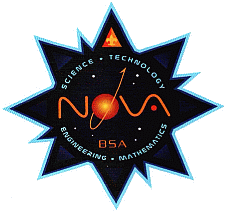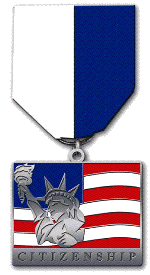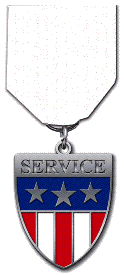

FORT RUCKER
TROOP 50

AWARDS

This page serves as a resource to link Scouts and their parents to awards that a Scout can earn in addition to their regular Rank requirements and Merit Badges.
This Award is meant for Boy Scouts.
Now when a Scout excels in outdoor participation, there are new awards to show for it! This program, conceived by the National Camping Task Force of the BSA®, includes a series of five badges designed to recognize a Boy Scout or Varsity Scout who has exemplary knowledge and experience in performing high-level outdoor activities.
The five National Outdoor Award Badges recognize a Boy Scout or Varsity Scout who demonstrates both knowledge and experience in camping, hiking, aquatics, riding, and adventure. Scouts earning the National Outdoor Award Badges have demonstrated that they are knowledgeable, safe, and comfortable in the outdoor activity covered by the badge.
The award consists of five emblem segments positioned around the perimeter of a beautiful center emblem. When the first badge is earned, the scout receives the center patch and earned segment. Additional segments are added as the badges are earned. The segments represent five areas of emphasis: Riding, Hiking, Camping, Aquatics, and Adventure, with rigorous requirements to earn each segment.
These awards replace the individual National Camping award.
Click on the individual segment patches to link to the worksheet for that segment.
National Medal for Outdoor Achievement
The National Medal for Outdoor Achievement is the highest recognition that a Boy Scout or Varsity Scout can earn for exemplary achievement, experience, and skill in multiple areas of outdoor endeavor. In order for a Scout to earn the National Medal for Outdoor Achievement, the Scout must complete the following requirements:
-
Earn the First Class rank.
-
Earn the National Outdoor Badge for Camping with a silver device.
-
Earn any two additional National Outdoor Badges, each with two gold devices.
-
Earn the following merit badges: Backpacking, Emergency Preparedness, Nature, and Wilderness Survival.
-
Complete a 16-hour course in Wilderness First Aid from the American Red Cross, Wilderness Medical Institute, or other recognized provider.
-
Become a Leave No Trace Trainer by completing the 16-hour training course from a recognized Leave No Trace Master Educator.
-
Plan and lead, with the approval of your unit leader, an outing for your troop, team, patrol, or squad in two of the following activity areas: hiking and backpacking, aquatic activities, or riding. Include in each outing a service element addressing recreational impacts resulting from that type of activity. With the approval of your unit leader, you may plan and lead the outings for another Cub Scout pack, Boy Scout troop, Varsity Scout team, Sea Scout ship, or Venturing crew.
-
Complete at least one of the following:
-
Plan and lead, with the approval of your unit leader, an adventure activity identified in the National Outdoor Badge for Adventure for your troop, team, patrol, or squad.
-
Successfully complete a season on a council summer camp staff in an outdoor area, such as aquatics, Scoutcraft, nature/environment, climbing, or COPE.
National Outdoor Award Badges


Starting in 2012, the BSA began to offer The BSA NOVA Awards. They are available to all youth registered in the BSA. There are awards designed for youth in the Cub Scout, Boy Scout, and Venturing programs, and are optional in each program. Requirements must be completed while registered in the BSA in the appropriate program and subject to standard age limitations.
There are four Nova awards in each program — one for each STEM (Science, Technology, Engineering, Math) area — and a member can earn all four in each program level.
Completion of any Nova award earns a youth member the right to wear the Nova award patch.
Completion of each additional STEM Nova award is recognized by a pi (π) pin placed on the patch.
Each award builds on the STEM-related topic, involves hands-on activities, and often includes a field trip. Click on the icons to the left for more infomration and each of the worksheets.
Shoot! This module is designed to help you explore how science affects your life each day.
Start Your Engines! This module is designed to help you explore how technology affects your life each day.
Whoosh! This module is designed to help you explore how engineering affects your life each day.
Designed to Crunch! This module is designed to help you explore how math affects your life each day.
Supernova Awards
If you thrive on challenge, then earning one or both of the Supernova awards will be right up your alley. To be eligible, you must be a First Class Scout or higher. As a prerequisite, you must first earn any three of the four Nova awards for Boy Scouts. With your parent’s and unit leader’s help, you must select a council-approved mentor who is a registered Scouter. You may NOT choose your parent or your unit leader (unless the mentor is working with more than one youth).
Dr. Bernard Harris Supernova Award
Thomas Edison Supernova Award
BSA NOVA Awards
Conservation and the Boy Scouts of America have been partners for a long time. Camping, hiking, and respect for the outdoors are a part of the Scouting heritage. Many of the requirements for advancement from Tenderfoot through Eagle Scout rank call for an increasing awareness and understanding of the natural sciences. Many former Scouts have become leaders in conserving our environment and protecting it from abuse. Right now Scouts are involved in learning about environmental problems and actively working to make a difference.
This awards program was created to recognize those that have made significant contributions to conservation. It was begun in 1914 by Dr. William T. Hornaday, director of the New York Zoological Park and founder of the National Zoo in Washington, D.C. Dr. Hornaday was an active and outspoken champion of natural resource conservation and a leader in saving the American bison from extinction. He named the award the Wildlife Protection Medal. Its purpose was to challenge Americans to work constructively for wildlife conservation and habitat protection. After his death in 1937, the award was renamed in Dr. Hornaday's honor and became a Boy Scouts of America award.
Since 1917, about 1,100 Hornaday medals have been awarded. The Wildlife Protection Medal was a forerunner to the Hornaday Awards. Dr. William T. Hornaday, an ardent conservationist, established this awards program to recognize Scouts who undertook and completed truly exceptional conservation projects. Earning one is hard work—it is supposed to be—but it's worth it.
A good idea is to start with the badge and then work up to the bronze or silver medal. You must be a First Class Scout or a Venturer, and you must have a conservation adviser. Then you do your homework to fulfill the advancement requirements and conservation projects you want to complete.
The following merit badges and project categories are the building blocks for a Scout to earn a Hornaday Award. See the Hornaday application for the Venturing requirements.
MERIT BADGES
Energy
Environmental Science
Fish and Wildlife Management
Forestry
Public Health
Soil and Water Conservation
Bird Study
Fishing
Fly-Fishing
Gardening
Geology
Insect Study
Landscape Architecture
Mammal Study
Nature
Nuclear Science
Oceanography
Plant Science
Pulp and Paper
Reptile and Amphibian Study
Weather
*FOR THE HORNADAY BADGE, Scouts earn three of the merit badges listed above in boldface, plus any two others. Then plan, lead, and carry out a significant project in natural resource conservation, from one of the project categories listed.
*FOR THE HORNADAY BRONZE MEDAL, Scouts earn the Environmental Science merit badge and at least three additional merit badges listed above in boldface, plus any two others. Then plan, lead, and carry out three significant projects from three separate categories listed.
*FOR THE HORNADAY SILVER MEDAL, Scouts earn all the merit badges listed above in boldface, plus any three others. Then plan, lead, and carry out four significant projects in natural resource conservation or environmental improvements, one each from four of the eight project categories listed:
Energy conservation
Soil and water conservation
Fish and wildlife management
Forestry and range management
Air and water pollution control
Resource recovery (recycling)
Hazardous material disposal and management
Invasive species control
William T. Hornaday Awards
50 Miler Award
The 50-Miler Award is presented to each qualifying individual for satisfactory participation in an approved trip. In order to qualify for the award the group of which the individual is a member must fulfill all of the following requirements.
1. Make complete and satisfactory plans for the trip, including the possibilities of advancement.
2. Cover the trail or canoe or boat route of not less than 50 consecutive miles; take a minimum of five consecutive days to complete the trip without the aid of motors. (In some areas pack animals may be used.)
3. During the time on the trail or waterway, complete a minimum of 10 hours each of group work on projects to improve the trail, springs, campsite, portage, or area. If, after checking with recognized authorities, it is not possible to complete 10 hours each of group work on the trail, a similar project may be done in the unit's home area. (There should be no unauthorized cutting of brush or timber.)
Unit or tour leader must then file a 50-Miler Award application with the local council service center.
Click on the patch to link to the application which gives additional details about planning the trip.
Historic Trails Award
To bring appreciation to the ideals, principles, and traditions that have made our country strong. The requirements emphasize cooperation between historic societies and Boy Scout, Varsity Scout, and Venturing units, which should establish a close relationship with a local society as soon as possible when planning a historic activity—most communities have such societies.
To earn the award, members of your unit must plan and participate in a historic activity. A unit historic activity requires members to:
1. Locate a historic trail or site and study information relating to it. (The information may be obtained from an adult historic society, public library, or people living near the trail or site.)
2. Hike or camp two days and one night along the trail or in the vicinity of the site.
3. Cooperate with an adult group such as a historic society to restore and mark all or part of this trail or site. (This may be done during the hike or overnight camp.) Or cooperate with such a group to plan and stage a historic pageant, ceremony, or other public event related to this trail or site - such event should be large enough to merit coverage by the local press.
Your unit leader must then file the Historic Trails Award application with your council service center.
Click on the patch to link to the application for more information.
Triple Crown Award
The Charles L. Sommers Alumni Association, Inc. (a Minnesota 501(c)3 organization) in conjunction with the Boy Scouts of America have authorized the issuance of a special certificate and patch to honor those who have participated in at least one high adventure program at each of the three high adventure bases operated by the National Council of the Boy Scouts of America. These bases are:
Philmont Scout Ranch (including the Double H Ranch)
Northern Tier High Adventure Bases (Ely, Atikokan, and Bissett),
Florida National High Adventure Sea Base.
The High Adventure Triple Crown award is available to scouts and scouters. There is no time limit on earning the award. Some participation requirements can be completed as a youth and the rest as an adult.
To receive the High Adventure Triple Crown award, you must complete any high adventure program at all three BSA national High Adventure bases; these can be summer or winter programs.
The basic rule is that if you receive a participant emblem/patch from the High Adventure base during your program, it qualifies as your participation requirement for that BSA high adventure base. Programs hosted by the three bases and their satellites that do not qualify for earning a BSA high adventure participant award do not qualify as meeting the Triple Crown requirement.
You will need to supply the program, crew number, dates, and staff member name for each of your three high adventure treks.
Click on the patch to link to the application for more information.
"Patriotism is not a short and frenzied outburst of emotion but the tranquil and steady dedication of a lifetime."
Adlai Stevenson
23rd Vice-President of the United States
The Patriot Awards were designed to lead youth of the United States to a greater understanding of the amazing legacy we were given by our founding fathers. This legacy has afforded every person in the United States abounding freedoms that are often taken for granted.
These awards present the youth an opportunity to receive recognition for learning, working with family, working with people of varied race, creed, and gender, and experiencing the Heritage, Freedom, Citizenship, and Service of the United States of America. It is our hope that the youth will develop a stronger sense of themselves, their community, and their nation. We also hope that the adults in the youth's life will also pass on their heritage and learn more about this great land.
By completing each segment of the Youth Patriotism Awards, the youth earns a medal signifying their accomplishment and encouraging others to do the same.
All requirements can be done with a unit, group, family, or individually. Click the Award logo to link to the website for further information. And each medal to link to the available worksheets.

















